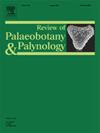Monitoring seasonal pollen deposition in an arid environment using Tauber traps: ecological and aerobiological insights from Kashan, central Iran
IF 1.7
3区 地球科学
Q2 PALEONTOLOGY
引用次数: 0
Abstract
Monitoring atmospheric pollen deposition with Tauber traps has long supported palaeoecological studies in temperate regions of Europe, but their application in arid regions and their potential in aerobiology remain underexplored. We installed Tauber traps at three sites in Kashan and neighboring towns on the western margin of the central Iranian desert, with weekly and monthly (4-weekly) collections over one year, to assess their efficiency in capturing seasonal airborne pollen. The traps reliably reflected both regional desert-steppe vegetation and urban or peri-urban plantations. Comparison with clinical allergy data shows that Chenopodiaceae (s. str.) and Artemisia, together with Morus alba, Olea europaea, and Cupressus, are the major airborne allergens in Kashan. Our findings stress that the allergenic importance of Chenopodiaceae and Artemisia—dominant in summer and autumn pollen rains—has been underestimated in regional aerobiological surveys and clinical testing, which typically rely on a narrow set of non-native extracts. We propose that Tauber traps, as a simple and inexpensive tool, could complement aerobiological monitoring in remote drylands and inform both ecological and medical studies.
利用陶伯捕集器监测干旱环境中的季节性花粉沉积:来自伊朗中部卡尚的生态和有氧生物学见解
利用陶伯捕集器监测大气花粉沉积长期以来一直支持欧洲温带地区的古生态学研究,但其在干旱地区的应用及其在空气生物学中的潜力仍未得到充分探索。我们在伊朗中部沙漠西部边缘的卡尚和邻近城镇的三个地点安装了陶伯捕集器,在一年的时间里每周和每月(4周)收集一次,以评估它们捕捉季节性空气传播花粉的效率。捕集器可靠地反映了区域荒漠草原植被和城市或城郊人工林。与临床变态反应资料比较发现,喀山地区空气中主要的变态反应原为藜科(s.s str.)和青蒿科,以及桑、油橄榄和柏树。我们的研究结果强调,Chenopodiaceae和蒿属植物在夏季和秋季花粉雨中占主导地位,在区域空气生物学调查和临床试验中被低估了,这些调查和临床试验通常依赖于一组狭窄的非本地提取物。我们建议,陶伯捕集器作为一种简单而廉价的工具,可以补充偏远旱地的空气生物学监测,并为生态和医学研究提供信息。
本文章由计算机程序翻译,如有差异,请以英文原文为准。
求助全文
约1分钟内获得全文
求助全文
来源期刊
CiteScore
3.50
自引率
21.10%
发文量
149
审稿时长
6 months
期刊介绍:
The Review of Palaeobotany and Palynology is an international journal for articles in all fields of palaeobotany and palynology dealing with all groups, ranging from marine palynomorphs to higher land plants. Original contributions and comprehensive review papers should appeal to an international audience. Typical topics include but are not restricted to systematics, evolution, palaeobiology, palaeoecology, biostratigraphy, biochronology, palaeoclimatology, paleogeography, taphonomy, palaeoenvironmental reconstructions, vegetation history, and practical applications of palaeobotany and palynology, e.g. in coal and petroleum geology and archaeology. The journal especially encourages the publication of articles in which palaeobotany and palynology are applied for solving fundamental geological and biological problems as well as innovative and interdisciplinary approaches.

 求助内容:
求助内容: 应助结果提醒方式:
应助结果提醒方式:


